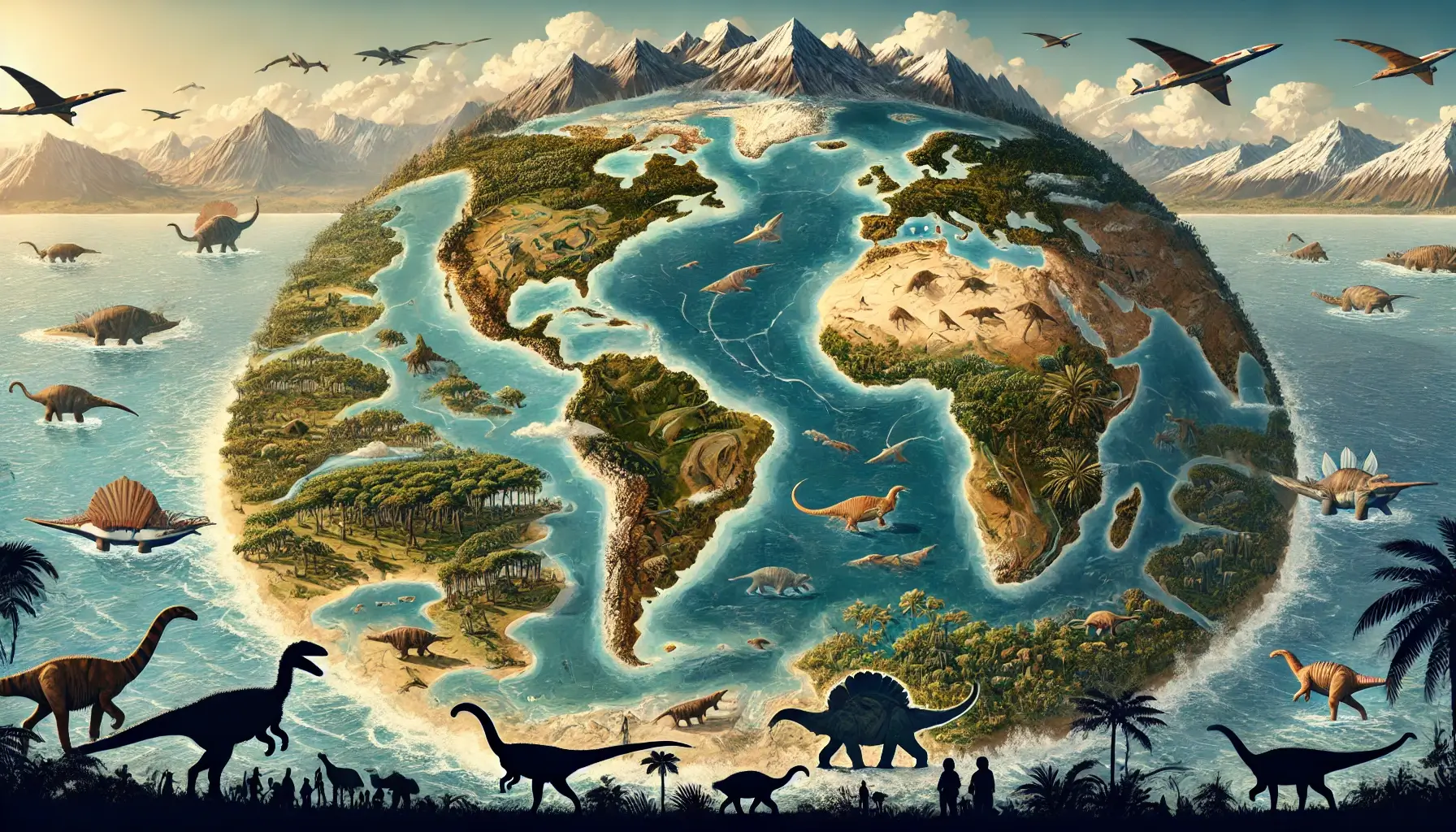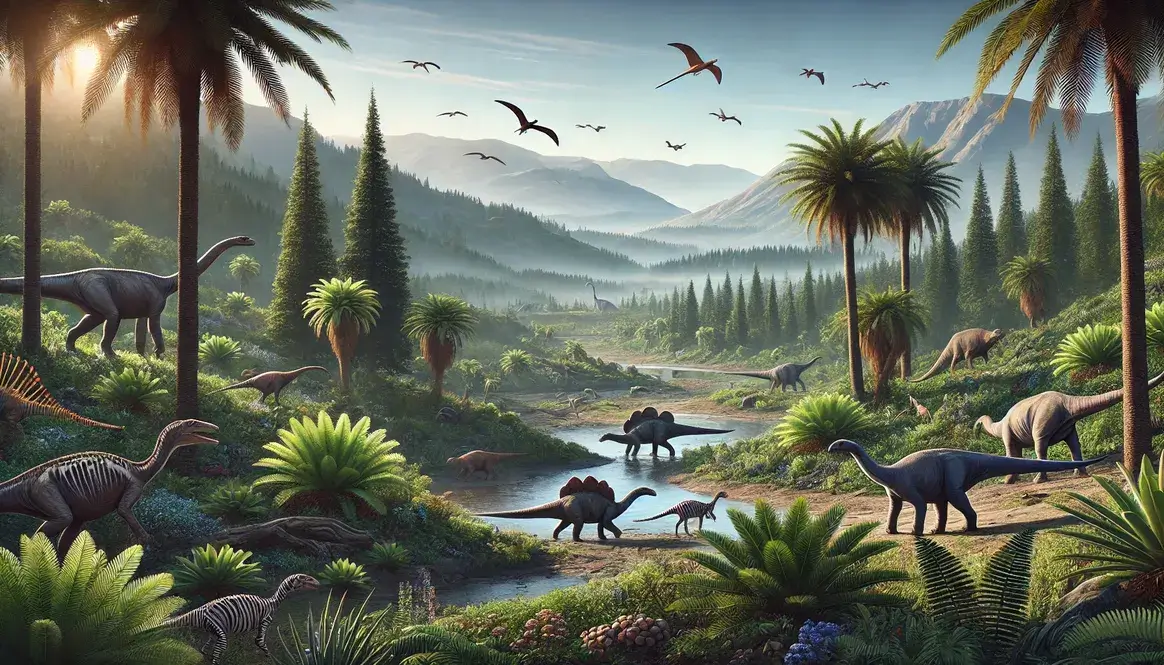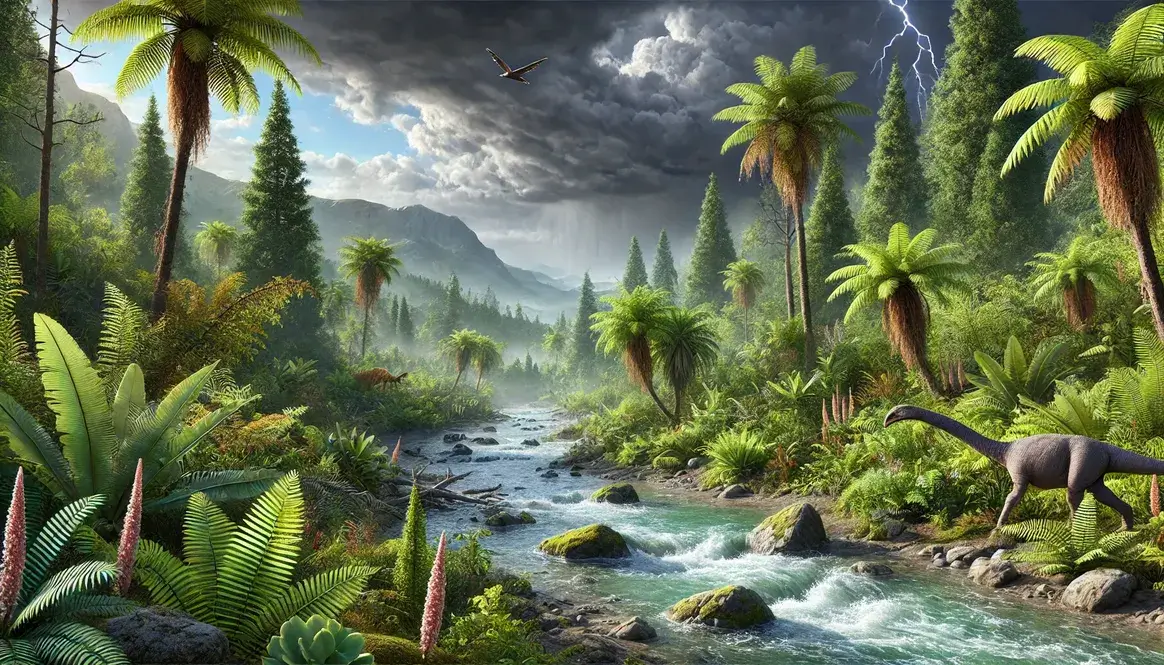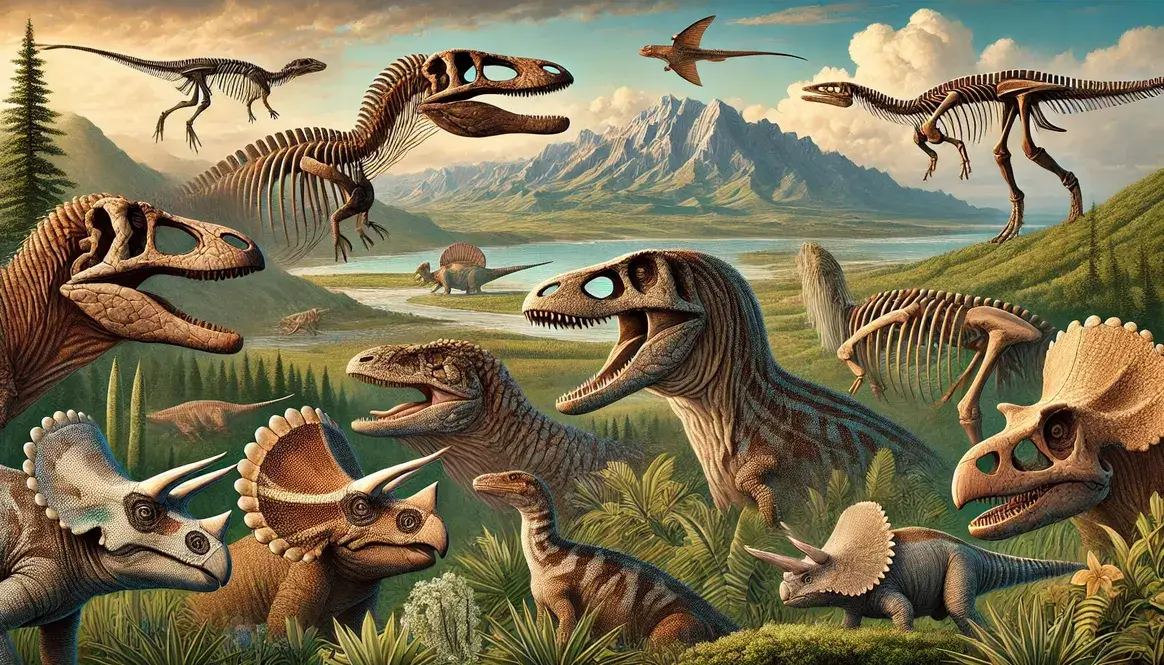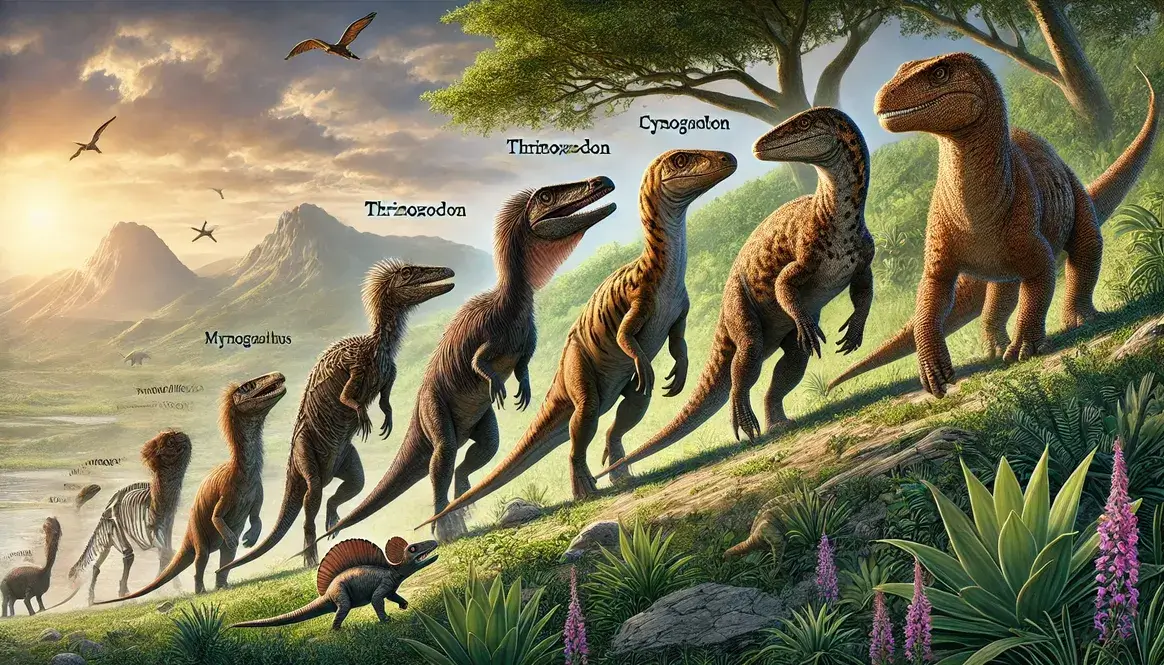Picture a world where all of Earth’s continents were squished together like a giant jigsaw puzzle. That’s Pangaea, the supercontinent that existed during the Triassic period, about 252 to 201 million years ago. This massive landmass played a huge role in shaping our planet’s history, influencing everything from climate to the evolution of life. Let’s dive into the fascinating world of Triassic Pangaea and discover how it changed the face of Earth!
The Formation and Structure of Pangaea
Pangaea didn’t just appear overnight. It took millions of years of slow continental movement to create this supercontinent. Let’s take a closer look at how Pangaea came to be and what it looked like during the Triassic period.
Assembly of Pangaea
Imagine Earth’s continents as giant puzzle pieces floating on the planet’s surface. Over millions of years, these pieces gradually came together to form Pangaea. Here’s a simple timeline of how it happened:
- About 335 million years ago: The southern continents started to join up, forming a landmass called Gondwana.
- Around 320 million years ago: The northern continents began to merge, creating Laurasia.
- By 300 million years ago: Gondwana and Laurasia collided, forming the supercontinent Pangaea.
The main players in this continental collision were:
- Gondwana (made up of Africa, South America, Australia, Antarctica, and India)
- Laurasia (North America, Europe, and Asia)
- Smaller landmasses like Siberia and North China
Geographical Features of Triassic Pangaea
Pangaea wasn’t just a flat, boring landmass. It had a variety of interesting features that made it unique:
- Coastlines and inland seas: Pangaea was surrounded by a giant ocean called Panthalassa. There was also a huge bay on the eastern side called the Tethys Sea, which would later become the Mediterranean Sea.
- Mountain ranges and lowlands: The collision of continents created massive mountain ranges, like the Appalachians in North America and the Ural Mountains in Russia. There were also vast lowland areas and river valleys.
- Central desert: The heart of Pangaea was mostly desert, as moisture from the surrounding oceans couldn’t reach the interior.
Climate Effects of the Supercontinent
Pangaea’s unique structure had a big impact on Earth’s climate during the Triassic period. Let’s explore how this massive landmass influenced weather patterns and created some extreme environments.
Global Climate Patterns in Triassic Pangaea
The Triassic climate was generally warm and dry, but Pangaea made things even more extreme. Here’s how it compared to today’s climate:
| Triassic Pangaea | Modern Earth |
|---|---|
| One giant continent | Multiple continents |
| Extreme seasonal changes | More moderate seasons |
| Vast interior deserts | Diverse climate zones |
| Strong monsoons | Various regional weather patterns |
Monsoon Systems and Seasonal Extremes
Pangaea’s massive size and unique shape created weather patterns that would make modern meteorologists’ heads spin. Picture monsoons on steroids, with storms that would make our fiercest hurricanes look like gentle spring showers.
These super-charged weather systems were driven by extreme temperature differences between:
- The vast land area of Pangaea
- The surrounding Panthalassic Ocean
Without separate continents and oceans to moderate temperatures, some regions experienced wild swings from scorching summers to freezing winters. It was like Earth’s thermostat went haywire, creating a climate rollercoaster that modern plants and animals would struggle to survive.
Interior Desert Regions
If you thought the Sahara was big, you’d be floored by Pangaea’s central deserts. These mega-deserts sprawled across the heart of the supercontinent, making today’s arid regions look like lush oases.
Why so dry? Rain clouds from the coastal areas simply couldn’t make it this far inland, leaving the interior parched and barren. Life in these deserts was tough, to say the least:
- Daytime: Scorching heat that would make even cacti sweat
- Nighttime: Bone-chilling cold as heat rapidly escaped into the atmosphere
- Survival: Only the most adaptable creatures could thrive in these extreme conditions
Coastal Areas and Their Climate
While the interior of Pangaea was giving desert-dwellers a run for their money, the coastal regions were living it up. These areas enjoyed a much more hospitable climate, with:
- Milder temperatures
- More consistent rainfall
- Greater biodiversity
It’s no wonder these zones became the ancient equivalent of beachfront property – prime real estate for Triassic life. Plants and animals flourished in these coastal havens, creating diverse ecosystems that stood in stark contrast to the barren interior.
Impact on Ocean Circulation
Pangaea’s formation didn’t just reshape the land – it completely rewrote the rules for ocean currents. With one massive continent surrounded by a single ocean, the familiar current patterns we know today were turned on their head.
| Aspect | Impact |
|---|---|
| Nutrient distribution | Altered feeding patterns for marine life |
| Water temperature | Changed habitable zones for various species |
| Breeding grounds | Shifted, affecting migration and reproduction |
These new ocean patterns didn’t just affect life beneath the waves. They also influenced global climate patterns, contributing to the extreme weather conditions on land. It’s a perfect example of how interconnected Earth’s systems are – a change in one area can have ripple effects across the entire planet.
For a deeper dive into the Triassic climate and its effects on life, check out our article on climate conditions during the Triassic period.
Impact on Animal Distribution and Evolution
Pangaea wasn’t just a playground for weather patterns – it was also a stage for some of the most dramatic evolutionary stories in Earth’s history. Let’s explore how this supercontinent shaped the animal world of the Triassic.
Terrestrial Animal Movement
Imagine a world with no oceans blocking your path. That’s what life was like for land animals on Pangaea. This continental connectivity had some big implications:
- No-hassle travel: Animals could roam freely across vast distances without needing to cross water barriers.
- Meet-and-greet opportunities: Different species that evolved in isolation could now encounter each other, leading to new interactions and competitions.
- Climate tourism: Creatures could migrate to find their ideal climate zones as the weather changed.
This ease of movement played a crucial role in the spread of early dinosaurs and other reptiles. It’s like nature set up a prehistoric highway system for species distribution!
Evolutionary Pressures
Life on Pangaea wasn’t all smooth sailing, though. The diverse and often harsh environments of the supercontinent pushed animals to adapt in fascinating ways:
- Desert survivors: Animals in the arid interior developed ways to conserve water and tolerate extreme heat.
- Mountain climbers: Species living in the newly formed mountain ranges adapted to high altitudes and rugged terrain.
- Coastal dwellers: Creatures near the shores evolved to take advantage of the more moderate climates and abundant resources.
These pressures led to the development of new survival strategies. It was like a massive, continent-wide experiment in adaptation!
Early Dinosaurs in Pangaea
While Pangaea was home to a variety of creatures, it also set the stage for the rise of one of the most famous animal groups in Earth’s history – the dinosaurs.
The first dinosaurs appeared during the Triassic period, taking advantage of the connected landmass to spread and diversify. These early dinos were generally small and nimble, a far cry from the giants we often imagine when we think of dinosaurs.
Want to learn more about these prehistoric pioneers? Check out our article on the first dinosaurs of the Triassic period.
Other Notable Triassic Animals
Dinosaurs weren’t the only game in town during the Triassic. Pangaea was teeming with a variety of fascinating creatures:
- Synapsids: These “mammal-like reptiles” were the ancestors of modern mammals. They came in all shapes and sizes, from small shrew-like creatures to large predators.
- Early mammals: The first true mammals appeared during this time, though they were still small and likely nocturnal.
- Other reptiles: Crocodile ancestors, lizard-like creatures, and the first turtles all called Triassic Pangaea home.
Impact on Plant Distribution and Evolution
Just like animals, plants had to adapt to the unique conditions of Pangaea. Let’s explore how the supercontinent shaped the green world of the Triassic.
Major Plant Groups of Triassic Pangaea
The plant life of Pangaea was diverse and fascinating. Here’s a quick rundown of the major players:
- Conifers: These cone-bearing trees were becoming increasingly dominant.
- Cycads: Palm-like plants that were common in many areas.
- Ginkgoes: Ancestors of the modern ginkgo tree were widespread.
- Ferns: These ancient plants continued to thrive in many habitats.
- Horsetails: Larger versions of modern horsetails were common in wet areas.
For a more in-depth look at the flora of this period, hop over to our article on Triassic plants and their evolutionary significance.
Plant Adaptation to Pangaean Climates
Pangaea’s extreme environments pushed plants to develop some clever survival tricks:
- Water-wise wonders: Plants in drier areas evolved thick, waxy leaves to retain moisture.
- Sun-smart strategies: Some plants developed reflective surfaces or hair-like structures to cope with intense sunlight.
- Cold-hardy heroes: Plants in higher latitudes adapted to survive long, dark winters.
These adaptations led to the evolution of many drought-resistant plants. It’s like nature’s version of extreme makeover, plant edition!
Seed Dispersal Across the Supercontinent
Pangaea’s connected landmass was a game-changer for plant spread:
- No ocean, no problem: Seeds could potentially travel across the entire supercontinent without facing water barriers.
- Animal assistants: As animals roamed freely, they helped disperse seeds over long distances.
- Wind riders: Wind-dispersed seeds could potentially travel further in the open landscapes of Pangaea.
This continental connectivity encouraged plants to develop new dispersal mechanisms. Some seeds evolved hooks to catch on animal fur, while others developed wing-like structures for better wind travel. It was like a prehistoric arms race in seed dispersal technology!
Breakup of Pangaea: Seeds of Change
All good things must come to an end, and Pangaea was no exception. Let’s explore how this supercontinent began to break apart and the profound effects this had on life and climate.
Early Signs of Continental Rifting
Towards the end of the Triassic period, Pangaea started showing signs of splitting up. It was like Earth decided to play a massive game of tug-of-war with the continents!
- Cracking up: Around 200 million years ago, cracks began to form in Pangaea’s crust.
- Stretching out: These cracks, or rift valleys, slowly widened as the continental plates pulled apart.
- Making waves: As the rifts grew, seawater rushed in, forming new seas and changing coastlines.
One of the most significant rifts formed between North America and Africa, eventually becoming the Atlantic Ocean. It’s mind-boggling to think that the vast Atlantic started as a crack in Pangaea!
Impact on Climate and Life
The breakup of Pangaea wasn’t just a change in geography – it had far-reaching effects on climate and the distribution of life:
- Climate shake-up: As new seas formed, they began to influence weather patterns. Areas that were once dry continental interiors started getting more rainfall.
- New neighborhoods: The formation of new coastlines created fresh habitats for plants and animals to colonize.
- Isolation nation: As landmasses drifted apart, populations of plants and animals became separated, setting the stage for divergent evolution.
These changes didn’t happen overnight – they took millions of years. But they set in motion processes that would eventually lead to the diverse world we know today.
The breakup of Pangaea coincided with one of the most significant extinction events in Earth’s history. To learn more about this pivotal moment, check out our article on the Triassic-Jurassic extinction event.
Pangaea’s Legacy
Even though Pangaea is long gone, its influence continues to shape our world in fascinating ways.
Long-term Effects on Evolution
Pangaea’s existence and breakup had a profound impact on the evolution of life:
- Diversity boom: The isolation of populations as continents separated led to an explosion of new species.
- Extinction and opportunity: While some species couldn’t adapt to the changing world, others found new niches to exploit.
- Biogeographical puzzles: The distribution of plants and animals today often reflects their origins on Pangaea.
For example, the presence of similar fossil species on continents now separated by vast oceans is a direct result of their shared history on Pangaea. It’s like finding puzzle pieces that still fit together after 200 million years!
Geological Remnants
Pangaea may be gone, but it left behind plenty of clues for scientists to study:
- Mountain memories: Many of today’s mountain ranges, like the Appalachians and the Atlas Mountains, were formed during the assembly of Pangaea.
- Rock records: Matching rock formations on different continents help geologists piece together Pangaea’s structure.
- Fossil forensics: The distribution of fossil species across continents provides evidence of their past connections.
Today, scientists use a variety of tools to study Pangaea, from satellite imagery to computer models. It’s like being a detective, but instead of solving crimes, they’re unraveling the mysteries of Earth’s past!
Conclusion
Whew! We’ve covered a lot of ground (pun intended) in our exploration of Triassic Pangaea. Let’s recap the key points:
- Pangaea was a supercontinent that existed during the Triassic period, bringing all of Earth’s landmasses together.
- This massive continent created extreme climate conditions, from super-monsoons to vast interior deserts.
- Pangaea allowed animals and plants to spread widely, but also created evolutionary pressures that led to new adaptations.
- The breakup of Pangaea towards the end of the Triassic set the stage for the diverse world we know today.
Understanding Pangaea isn’t just about satisfying our curiosity about the past. It helps us make sense of the world we see today, from the distribution of species to the shape of our continents. It’s a reminder that our planet has a long, dynamic history, and that the world we know is just one snapshot in Earth’s ongoing story.

